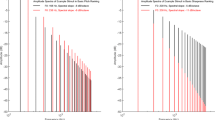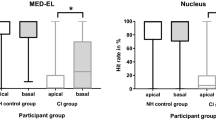Abstract
Music perception is considered unsatisfactory for most cochlear implant (CI) users. Usually, rhythm identification is adequate while pitch and melody recognition are rather limited. The aim of this study was to investigate whether insufficient contour information in the low-frequency range is one cause that contributes to the poor melody recognition results in CI users. For this purpose, the recognition of familiar melodies was tested with three differently expanded pitch contours. Ten cochlear implant subjects and five normal-hearing (NH) volunteers were investigated. Each subject chose ten out of a possible set of 23 well-known nursery songs without verbal cues. The songs were played in the original version and with three different pitch-contour expansions. All versions were tested with and without rhythm and in random order. CI subjects exhibited best results when melodies were presented with expanded pitch contours, although no clear preference for a specific contour modification was observed. Normal-hearing subjects exhibited poorer results for expanded pitch contours, especially when testing without rhythm. Both NH and CI-user groups exhibited large inter-individual differences, and melody recognition with rhythm was always better than melody recognition without rhythm. Insufficient contour information in the low-frequency range is confirmed as one contributing cause for the poor melody recognition results in CI users. Therefore, other efforts to improve low-frequency pitch discrimination, e.g., a more sophisticated design of the electrode array, a focus of the electrical stimulation pattern or an improved signal processing scheme could potentially improve melody recognition as well.





Similar content being viewed by others
References
Zeng FG (2004) Trends in cochlear implants. Trends Amplif 8:T1–T34
Kang R, Nimmons GL, Drennan W, Longnion J, Ruffin C, Nie K, Won JH, Worman T, Yueh B, Rubinstein J (2009) Development and validation of the university of Washington clinical assessment of music perception test. Ear Hear 30:411–418
Singh S, Kong YY, Zeng FG (2009) Cochlear implant melody recognition as a function of melody frequency range, harmonicicty, and number of electrodes. Ear Hear 30:160–168
Kong YY, Cruz R, Jones JA, Zeng FG (2004) Music perception with temporal cues in acoustic and electric hearing. Ear Hear 25(2):173–185
McDermott HJ, McKay CM (1997) Musical pitch perception with electrical stimulation of the cochlea. J Acoust Soc Am 101(3):1622–1630
Gfeller K, Turner C, Mehr M, Woodworth G, Fearn R, Knutson JF, Witt S, Stordahl J (2002) Recognition of familiar melodies by adult cochlear implant recipients and normal-hearing adults. Cochlear Implants Int 3(1):29–53
Mirza S, Douglas SA, Lindsey P, Hildreth T, Hawthorne M (2003) Appreciation of music in adult patients with cochlear implants: a patient questionnaire. Cochlear Implants Int 4(2):85–95
McDermott HJ (2004) Music perception with cochlear implants: a review. Trends Amplif 8(2):49–82
Pijl S (1997) Labeling of musical interval size by cochlear implant patients and normally hearing subjects. Ear Hear 18:364–372
Cooper WB, Tobey E, Loizou PC (2008) Music perception by cochlear implant and normal-hearing listeners as measured by the Montreal battery for evaluation of amusia. Ear Hear 29:618–626
Fujita S, Ito J (1999) Ability of nucleus cochlear implantees to recognize music. Ann Otol Rhinol Laryngol 108:634–640
Hiki S, Fukuda Y (2000) Pitch perception through the cochlear implant for speech and music. Adv Otorhinolaryngol 57:12–14
Loeb GE (2005) Are cochlear implant patients suffering from perceptual dissonance? Ear Hear 26:435–450
Milczynski M, Wouters J, van Wieringen A (2009) Improved fundamental frequency coding in cochlear implant signal processing. J Acoust Soc Am 125:2260–2271
Laneau J, Wouters J (2004) Relative contributions of temporal and place pitch cues to fundamental frequency discrimination in cochlear implantees. J Acoust Soc Am 116(6):3606–3619
Kwon BJ, van den Honert C (2006) Dual-electrode pitch discrimination with sequential interleaved stimulation by cochlear implant users. J Acoust Soc Am 120(v1):EL1–EL6
Donaldson GS, Kreft HA, Litvak L (2005) Place-pitch discrimination of single- versus dual-electrode stimuli by cochlear implant users. J Acoust Soc Am 118(2):623–626
Baumann U, Nobbe A (2004) Pitch ranking with deeply inserted electrode arrays. Ear Hear 25:275–283
Baumann U, Nobbe A (2006) The cochlear implant electrode-pitch function. Hear Res 213:34–42
Houtsma AJM, Smurzynski J (1990) Pitch identification and discrimination for complex tones with many harmonics. J Acoust Soc Am 87:304–310
Levitin DJ (1999) Memory for musical attributes. In: Cook PR (ed) Music, cognition and computerized sound: an introduction to psychoacoustics. MIT Press, Cambridge, pp 209–227
Leal MC, Shin YJ, Laborde ML, Calmels MN, Verges S, Lugardon S, Andrieu S, Deguine O, Fraysse B (2003) Music perception in adult cochlear implant recipients. Acta Otolaryngol 123:826–835
Koelsch S, Wittfoth M, Wolf A, Müller J, Hahne A (2004) Music perception in cochlear implant users: an event-related study. Clin Neurophysiol 115:966–972
Edworthy J (1985) Interval and contour in melody processing. Music Percept 2:375–388
Schubert E, Stevens C (2006) The effect of implied harmony, contour and musical expertise on judgments of similarity of familiar melodies. J New Music Res 35:161–174
Welker RL (1982) Abstraction of themes from melodic variations. J Exp Psychol Hum Percept Perform 8:435–447
Kim YE, Chai W, Garcia R, Vercoe B (2000) Analysis of a contour-based representation for melody. MIT Media Laboratory, Machine Listening Group. http://alumni.media.mit.edu/~chaiwei/papers/Kim.pdf. Accessed 29 July 2011
Dowling WJ, Bartlett JC (1981) The importance of interval information in long-term memory for melodies. Psychomusicology 1:30–49
Trehub SE, Morrongiello BA, Thorpe LA (1985) Children’s perception of familiar melodies: the role of intervals, contour, and key. Psychomusicology 5:39–49
Laneau J, Wouters J, Moonen M (2006) Improved music perception with explicit pitch coding in cochlear implants. Audiol Neurootol 11:38–52
Xu L, Zhou N, Chen X, Li Y, Schultz HM, Zhao X, Han D (2009) Vocal singing by prelingually-deafned children with cochlear implants. Hear Res 255(1–2):129–134
di Nardo W, Scorpecci A, Giannantonio S, Cianfrone F, Paludetti G (2011) Improving melody recognition in cochlear implants recipients through individualized frequency map fitting. Eur Arch Otorhinolaryngol 268:27–39
Aschendorff A, Kromeier J, Klenzner T, Laszig R (2007) Quality control after insertion of the nucleus contour and contour advance electrode in adults. Ear Hear 28:75–79
Spahr AJ, Litvak LM, Dorman MF, Bohanan AR, Mishra LN (2008) Simulating the effects of spread of electric excitation on musical tuning and melody identification with a cochlear implant. J Speech Lang Hear Res 51:1599–1606
Acknowledgments
This work was supported by a grant from Cochlear Ltd., London. We wish to thank Elizabeth Provan-Klotz and Dianne Mecklenburg for her very helpful comments reviewing this paper.
Author information
Authors and Affiliations
Corresponding author
Rights and permissions
About this article
Cite this article
Digeser, F.M., Hast, A., Wesarg, T. et al. Melody identification for cochlear implant users and normal hearers using expanded pitch contours. Eur Arch Otorhinolaryngol 269, 2317–2326 (2012). https://doi.org/10.1007/s00405-011-1885-3
Received:
Accepted:
Published:
Issue Date:
DOI: https://doi.org/10.1007/s00405-011-1885-3




